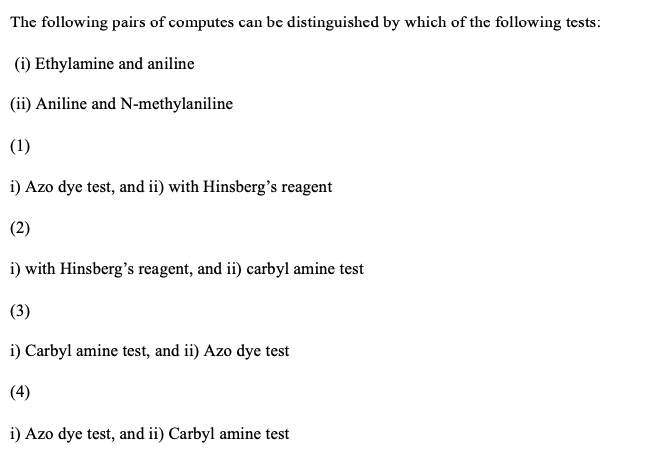Question
Question: The following pairs of computes can be distinguished by which of the following tests: (i) Ethylamin...
The following pairs of computes can be distinguished by which of the following tests:
(i) Ethylamine and aniline
(ii) Aniline and N-methylaniline

i) Azo dye test, and ii) with Hinsberg's reagent
i) with Hinsberg's reagent, and ii) carbyl amine test
i) Carbyl amine test, and ii) Azo dye test
i) Azo dye test, and ii) Carbyl amine test
i) Azo dye test, and ii) Carbyl amine test
Solution
The question asks for chemical tests to distinguish between the given pairs of compounds.
Pair (i): Ethylamine and aniline
- Ethylamine is an aliphatic primary amine (CH3CH2-NH2). Aniline is an aromatic primary amine (C6H5-NH2).
- Carbyl amine test: Both are primary amines, so both will give a positive carbyl amine test (foul-smelling isocyanide formation) with chloroform and alcoholic KOH. This test cannot distinguish between them.
- Hinsberg's reagent: Both are primary amines and react with benzenesulphonyl chloride to form N-substituted sulphonamides. These sulphonamides have an acidic hydrogen attached to nitrogen and are soluble in aqueous alkali. While there might be subtle differences, this is not the primary test used to distinguish aliphatic and aromatic primary amines.
- Azo dye test: Aromatic primary amines react with nitrous acid (prepared in situ from NaNO2 and HCl) at 0-5°C to form stable diazonium salts, which then couple with β-naphthol in alkaline solution to form an orange or red azo dye. Aliphatic primary amines react with nitrous acid to form unstable diazonium salts that decompose rapidly, evolving nitrogen gas. Thus, aniline gives a positive azo dye test (dye formation), while ethylamine gives effervescence (N2 evolution) but no dye formation. This test can distinguish them.
Pair (ii): Aniline and N-methylaniline
- Aniline is an aromatic primary amine (C6H5-NH2). N-methylaniline is an aromatic secondary amine (C6H5-NHCH3).
- Carbyl amine test: Primary amines give the carbyl amine test, while secondary and tertiary amines do not. Aniline (primary) will give a positive test (foul smell), while N-methylaniline (secondary) will not. This test can distinguish them.
- Hinsberg's reagent: Primary amines react to form sulphonamides soluble in alkali. Secondary amines react to form sulphonamides insoluble in alkali. Tertiary amines do not react. Aniline (primary) forms N-phenylbenzenesulphonamide, soluble in alkali. N-methylaniline (secondary) forms N-methyl-N-phenylbenzenesulphonamide, insoluble in alkali. This test can distinguish them.
- Azo dye test: Primary aromatic amines form diazonium salts that couple to form azo dyes. Secondary aromatic amines react with nitrous acid to form N-nitrosoamines (yellow oily liquids), which do not couple to form azo dyes. Aniline gives a positive azo dye test, while N-methylaniline does not. This test can distinguish them.
All three tests can distinguish between aniline and N-methylaniline. However, the options provide specific combinations.
Therefore, option (4) is the intended answer based on common practices and the provided similar question.
